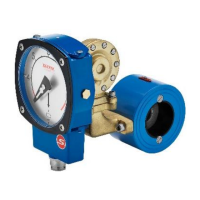25 5041 2E22
This makes it very easy to move one control unit from one pipe to another
Pipe Section on another pipe in order to check the function. It does not matter
what size the pipe section has, as we always work with the same on every
pipe size.
To check if the Monitor is showing the right desired and ordered value, it is
easy to remove the Flow Monitor from the pipe system and block the orifice
plate and apply the correct maximum pressure at the inlet. If you apply for ex-
ample 2000 mmH2O (196 mbar) on the S2/S02 and S2SS/S02SS series with a
blocked orifice, the pointer should reach the last digit 8 on the front scale and if
you have a direct reading scale installed, the pointer should reach the end value.
The same goes for a S25/S05 and S2SS/S02SS model, which should reach the
digit 5 if you apply a pressure of 5500 mmH2O (539 mbar).
You can of course also verify the flow in the Eletta Flow Monitor versus an-
other flow meter in the system or take the Monitor out and put in a flow test
rig, if you have the possibility.
If the above is not the case, there is a need to send the Monitor to the
Distributor or directly to The Eletta Service department for control.
If you find process liquid/gas coming out of the Control Unit;
Most probably you will find a broken lever, the small stainless steel shaft
going through a rubber sealing and it is attached to the diaphragm in the end.
If you have exposed the Monitor to excessive pressure (over 16 bar/232PSI
standard) or if the process liquid/gas is too aggressive to the rubber in the sea-
ling, it can cause the sealing to break.
Please check the identification plate/tag on the Monitor and write down the
serial number, flow range and liquid before ordering a new lever from your re-
presentative or us. If you have ordered a specially designed Flow Monitor i.e.
if it does not follow our standard execution, it must be checked what kind of
soft parts (diaphragm and seals) you have installed in the Flow Monitor. There
are three different kinds of rubber to order (see section 1.2 for details) and we
kindly ask you to provide us with the above information in order to help us
ship you the right material.
4.2
Electrical connections
Please always see to that you are using the right voltage and current (see sec-
tion 1.2) and that you have connected all the leads in a proper way (see section
2.7). If you open the cover on the Control Unit of the Monitors, it is normally

